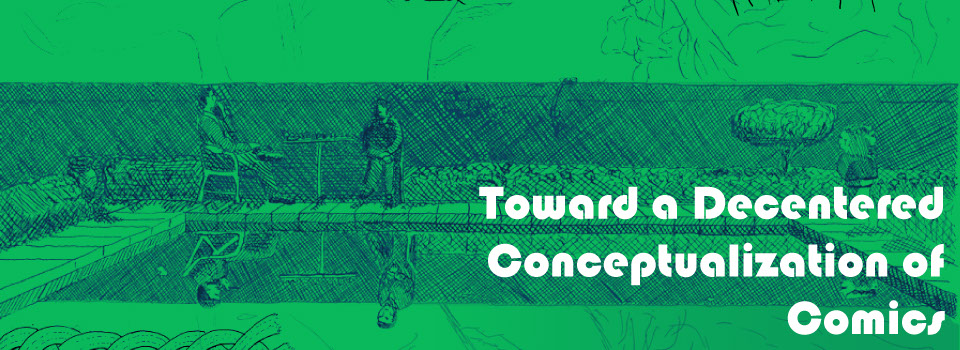
x
Contents
Home
Home
Home

The Given Is Not a Text
Jean-François Lyotard’s figure looms large here, as does his discourse. His first major work, Discourse, Figure (Discours, figure; not published in English until 2012), offers a sustained deconstruction of the image and text binary. Rodolphe Gasché describes Discourse, Figure as a parallel to Of Grammatology:
However different Lyotard's work may be from that of Derrida, Discours, Figure is a monument of deconstruction similar to Of Grammatology. Indeed, the notion of the figural which Lyotard develops in this book, a notion whose meaning shifts as the book unravels from an at first sensible connotation to a libidinal definition in order to finally be determined by the concept of difference, is the result of a deconstructive operation (“Deconstruction” 183-84; italics in original)
Lyotard’s deconstruction operates through a close analysis of figuration, that is to say, rhetoric. We tend to think of rhetorical figuration as primarily discursive. Lyotard complicates this assumption, showing that discourse is shot through with a figuration that exceeds discourse. This is one of the fundamental moves in deconstruction: show a binary in which one term is marked and the other unmarked (privileged). Then invert the binary by privileging the marked term. However, that is only the beginning of a deconstruction.
Lyotard’s primary interlocutor here is Lacan, with his structuralist approach to psychoanalysis. For Lacan, “the unconscious is structured like a language” (Lacan says this and things like it many times, but his fullest elaboration of the phrase is in One Feminine Sexuality, 48). In Discourse, Figure Lyotard argues that Lacan’s famous “return to Freud” is really a divergence from Freud, specifically in its fetishizing of discourse.
Lyotard therefore sets out to show two things: the verbal is incommensurate with the visual, and discourse is not figure. This is more than two binaries that must each be inverted: not one of these four terms corresponds with any of the others. We’ll walk through his progression slowly.
These first two claims are easy enough to elaborate. Lyotard begins his book with a direct jab at Derrida’s famous hors-texte. Discourse, Figure responds to Derrida implicitly, so we must return to the key points I outlined above and parse out Lyotard’s responses. First, here are Derrida’s points:
1. There is no outside-text (that is to say, we cannot appeal to a position outside of language that will once and for all establish meaning).
2. Resemblance is derivative of representation (not vice versa).
3. Any attempt to fix the gap between signifier and signified is doomed to fail (there is no transcendental signifier).
4. The center is no center, that is to say, there is no origin.
In the first chapter of Discourse, Figure, Lyotard lays out the stakes of his argument:
This book protests: the given is not a text, there is a density to it, or rather a difference, a constitutive difference which is not to be read, but to be seen, this difference, and the immobile mobility which reveals it, is what is continually forgotten in signifying it. (3)
Here my reasons for not completely siding with Derrida become evident. Whereas Derrida inverts the binary of speech and writing, Lyotard extends Derrida’s critique by inverting the binary of discourse and figure. The given is not a text. The (originary) act is not reading but seeing, of which reading is only an aspect.
Think of reading as a fold of seeing, one of the folds of which Derrida spoke and of which Deleuze would also speak. The fold, however, has grown strong, while the THIS out of which it folded has been left to atrophy. We see this particularly in the way images are often read while text is rarely seen, except perhaps in comics.
When referring to “originary” thus far, consider it to have been placed between parentheses, bracketed from sense. This is presaged by Derrida and by Lyotard’s extensive discussion of the arché:
Just as it follows that from a consideration of this rule the ego must be given up as a constituted unitary entity, so too it is high time that philosophers abandon the hope of producing a unitary theory as the last word on things. There is no arché, nor does the Good exist as a unitary horizon. One never touches the thing itself but metaphorically. However, this laterality is not, as Merleau-Ponty believed, that of existence—much too close already to the unity of the subject, as he himself conceded toward the end. This laterality is rather that of the unconscious or of expression, which in the same movement offers and holds back all content. This laterality is difference, or depth. (13-14)
This quote encapsulates the entire book. It at once displays the difficulty of Discourse, Figure and its basic organization. Lyotard moves from phenomenology to psychoanalysis. The multivocality of the origin is the hinge upon which these two turn. It also illustrates the connections that could be made to rhetoric and composition. Lyotard’s eschewal of a unitary subject rejects the hope of a unitary theory. This rejection parallels post-process theory’s rejection of a unitary writing process.
In a later chapter, Lyotard calls this THIS* by the name “matrix-figure”: that from out of which all discourse and figure erupts, yet itself having neither form nor sense:
To establish this matrix in textual space, all the more so if the latter is systematic, would be to imagine it as an arché, to entertain a double phantasy in relation to it: first, that of an origin; second, that of an utterable origin. Yet the phantasmatic matrix, far from being an origin, testifies to the contrary that our origin is an absence of origin and that everything that presents itself as object of an originary discourse is a hallucinatory figure-image, placed precisely in this initial non-site. (268-9)
The matrix cannot be textual because text indicates origin, a writer. The question of origin returns elusively. Where does meaning originate? In a sense, it is a question of intentionality. The fact of the matter is there is no origin. There is just a hole, a matrix-figure occupying a nonsite, because there can be no univocal, utterable origin. The matrix-figure takes the side of the figural, while not being a figure itself. What then of my earlier implications that the origin is somehow figural? Lyotard has just reminded us that unlike discourse, “The figure cannot lie, since it has no pretensions toward univocality” (266). An unlocatable origin can only by figural, since the figural does not strive for the coherence we expect of discourse.
We are finally approaching the THIS: Anaximander’s apeiron, the ur-stuff out of which existence exists. The apeiron signifies that which is perceived in the parallax view but that which is also constructed. We might look to Lacan’s triangle of Imaginary, Symbolic, and Real. In my example the imaginary and the symbolic occupy the places of each eye, while the real is that which is perceived and constructed through their mediation. Image and text conspire to divide the apeiron into meaning. By interweaving these modes, comics resist such division.
The interplay of figural* and discourse leads us toward Lyotard’s later development of the libidinal band. The libidinal band is a single surface, like a Mœbius strip. We might imagine this as an origin, but only a hypothetical and impossible one. One of the interesting things about the Mœbius strip is that when cut it does two different things. First, if we cut it along the middle, we get one very long strip with two sides. Second, if we instead cut it along an imaginary line a third of the way from the edge, we get two new strips, one with two sides and one new Mœbius strip, both strips being interlocked. This second cut signifies Lyotard’s formulation of the relationship between the disjunctive bar and the libidinal band. It also signifies the relationship between discourse and figure. Discourse is two-sided, binary, predicated by différance as Derrida has shown us. The figural, however could be likened more closely to this libidinal band.
Finally we have Lyotard’s differend: an imagined conversation across languages. My own idiomatic panmodal rhetoric bears witness to the differends of public|private, scholarly|popular, image|text, and a few others.
Lyotard responds to each of Derrida’s four key ideas, tangentially but never directly.
1. There is no outside-text (that is to say, we cannot appeal to a position outside of language that will once and for all establish meaning).
The given is not a text.
2. Resemblance is derivative of representation (not vice versa).
The figural is not primarily representational or resembling but creates the potential for each (as we will see).
3. Any attempt to fix the gap between signifier and signified is doomed to fail (there is no transcendental signifier).
The figural creates this gap (but likewise does not fix it).
4. The center is no center, that is to say, there is no origin.
If there is an origin, it can only ever be a pseudo-origin, hypothesized to allow us a theoretical framework.
Lyotard’s deconstruction inverts the binary between discourse and figure, privileging figure. Figure must be privileged because only it can create the discourse|figure binary we see around us. But it is through figure’s very difference from discourse that it refuses to provide a stable position. It cannot therefore really be privileged. Instead, it is the force of deconstruction, the energy that causes us to question privilege and to critique criticism, to move toward hyper-reflection. As Lyotard’s book progresses, the figural moves from a formal attribute to a phenomenological element to a psychoanalytic force. It retains its depth throughout.

but not différance or trace

the hors-texte is not a text!

phenomenology

psychoanalysis

*Lyotard’s figural is quite distinct from the figurative about which Deleuze and Guattari write in A Thousand Plateaus. Deleuze and Guattari link figuration to imitation and representation (497). Lyotard’s figural is not primarily representational but transgressive. As such, it corresponds more closesly (though never exactly) with Deleuze and Guattari’s abstract line (496-9).
*“However, this laterality is not . . . that of existence—much too close already to the unity of the subject . . . This laterality is rather that of the unconscious or of expression, which in the same movement offers and holds back all content. This laterality is difference, or depth.”
(13-14)
Such is the imaginary: to possess both this side and the other. Such is sin and pride: possessing both the text and the illustration. (Discourse, Figure 4)


